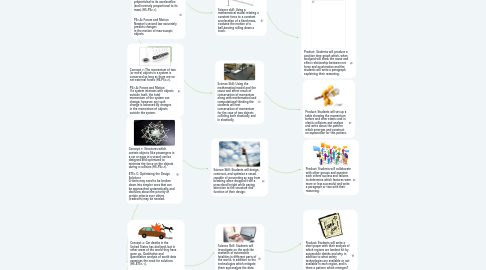Physics Crosswalk
by Paul Matsumoto

1. Concept 1: The net force an object experiences is directly proportional to its acceleration (and inversely proportional to its mass) (HS-PS2-1). PS2.A: Forces and Motion Newton's second law accurately predicts changes in the motion of macroscopic objects.
2. Science skill: Using a mathematical model relating a constant force to a constant acceleration of a fixed mass, evaluate the motion of a ball-bearing rolling down a track.
3. Started the year on kinematics. NGSS bundle includes HS-PS2-1; 2-2; 2-3; HS-ETS1-1; 1-3.
4. Concept 2: The momentum of two (or more) objects in a system is conserved as long as there are no net external forces (HS-PS2-2). PS2.A: Forces and Motion If a system interacts with objects outside itself, the total momentum of the system can change; however, any such change is balanced by changes in the momentum of objects outside the system.
5. Science Skill: Using the mathematical model and the cause and effect result of conservation of momentum along with mathematical and computational thinking the students will test conservation of momentum for the case of two objects colliding both elastically and in elastically.
6. Science Skill: Students will design, construct, and optimize a vessel capable of preventing an egg from breaking when dropped from a prescribed height while paying attention to the structure and function of their design.
7. Concept 3: Structures which contain objects (like passengers in a car or eggs in a vessel) can be designed and optimized to minimize the force on the objects during a collision (HS-PS2-3). ETS1.C: Optimizing the Design Solution1 Criteria may need to be broken down into simpler ones that can be approached systematically, and decisions about the priority of certain criteria over others (tradeoffs) may be needed.
8. Concept 4: Car deaths in the United States has declined, but in other areas of the world they have gone up. Qualitative and quantitative analysis of world data examines the need for solutions (HS-ETS1-1). ETS1.A: Defining and Delimiting Engineering Problems Criteria and constraints also include satisfying any requirements set by society, such as taking issues of risk mitigation into account, and they should be quantified to the extent possible and stated in such a way that one can tell if a given design meets them.
9. Science Skill: Students will investigate on the web the statistics of automobile fatalities in different parts of the world, in addition to the technologies which mitigate them and analyze the data to see if a pattern emerges.
10. Concept 5: Evalutate solutions to reducing automobile deaths around the world and the costs involved in implimenting the solutions including the possible social, cultural, and environmental impacts (HS-ETS1-3). ETS1.B: Developing Possible Solutions When evaluating solutions, it is important to take into account a range of constraints, including cost, safety, reliability, and aesthetics, and to consider social, cultural, and environmental impacts.
11. Science Skill: Students will (dividing into different groups than in previous parts of this unit) bring the results of their research in the previous four sections and collaborate, discuss, and evaluate their solutions to the problem of reducing automobile with their student sources of evidence and arrive at solutions including their tradeoff considerations.
12. Anchor Phenomena: Show the students video of a crash test dummies in slow motion
13. Product: Students will produce a position time graph which, when analyzed will show the cause and effect relationship between net force and acceleration and the students will write a paragraph explaining their reasoning.
14. Driving Question: How can we reduce deaths from automobile collisions?
15. Product: Students will set up a table showing the momentum before and after elastic and in elastic collisions and analyze and write about the pattern which emerges and construct an explanation for this pattern.
16. Product: Students will collaborate with other groups and examine each others success and failures to determine which features were more or less successful and write a paragraph or two with their reasoning.
17. Product: Students will write a short paper with their analysis of which regions are hardest hit by automobile deaths and why, in addition to what safety technologies are available or not available in each region, and is there a pattern which emerges?
18. Product: Students will create a group presentation to their solutions to reducing the numbers of automobile deaths and include the evaluations of potential problems and tradeoffs.
19. Initial Model Creation: Have students design an inital model showing the forces involved in the crash. Arrows and what the forces are involved in the collision.


